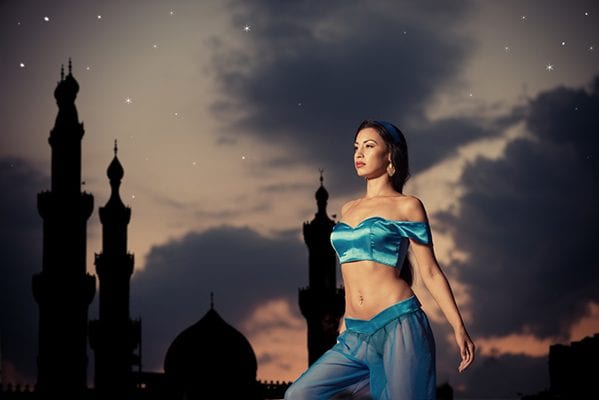One Thousand and One Nights
One Thousand and One Nights
One Thousand and One Nights
-
Hannah
-
Hannah

The culture of Spain has many influences and nuances (see, for example, my blog post on the Moors of Spain), and in my new novel, Indiscretion, I wanted to go beyond the traditional archetypes of the flamenco dancer and the toreador. So, for example, to attend a masked ball the heroine, Alexandra, dresses as a sultana of a bygone age:
… the magnificent sultana’s costume was made up of six distinct parts. First, there was a transparent jerkin that moulded to her body perfectly and was worn under a bodice with loose-fitting sleeves, in such fine ivory-coloured silk as to reveal the delicate curve of her small breasts. Over the bodice came a short bolero jacket, entirely embroidered with silver thread, seed pearls and precious stones. Loose-fitting trousers, also in ivory silk, clothed her legs in graceful folds; they were bound at the ankles with a bias band and held in at the waist by a wide belt, similarly embroidered with pearls and stones.
Alexandra studied the willowy image gazing back at her from the mirror, excitement lending her pearly complexion a glowing hue. Her large eyes, rimmed with thick brown lashes, seemed a deeper green now, seen through the narrow slits of the black velvet mask drawn across her face. She ran her fingers lovingly over the fabulous necklace encircling her swanlike neck and lifted her head proudly, smiling back at her reflection. Her image really did call to mind the mysterious characters from the tales of One Thousand and One Nights.
Of a bygone age, and also of a fairytale: the One Thousand and One Nights. No doubt you’ve heard of this collection of stories, sometimes called the Arabian Nights. Their influence has been so profound on culture (to the point that I found myself interweaving references in Indiscretion) that today I thought I would share something of the background.
The One Thousand and One Nights collection brings together stories from ancient and medieval Arabic, Persian, Indian, Egyptian and Mesopotamian folklore and literature. It was compiled over many centuries during the Islamic Golden Age (ninth to thirteenth centuries).
The first story, known as the framing story, is of the Persian king Shahryar, who takes against women. First he discovers his brother’s wife is cheating; then he finds his own wife is unfaithful. Disgusted, he executes his wife and then instigates a disturbing revenge on womankind: marry a virgin and execute her next morning, marry a virgin and execute her next morning, and so on. Then along comes Scheherazade. On their wedding night, this new bride cleverly tells Shahryar a tale, but she does not complete it. The king is so intrigued by the story that he stays her execution, and the next night Shahryar completes the story – and immediately starts another, before cutting off and leaving Shahryar wanting more. So the story-telling continues, for 1,001 nights.
The stories vary widely in tone and subject matters; some are histories; some love stories; some comedies; some magical stories; some animal fables; some rather erotic! There are even stories within the story within a story (called embedded narrative), making the overall work fantastically layered. There are also fantastic cliffhangers; in many ways, this work is the inspiration for our popular form of storytelling now in serial fiction and television works. Indeed, many modern storytelling techniques and genre conventions can be traced back to the work, from the Cinderella storyline to the plot twists required of the crime genre. And so many authors have been inspired by One Thousand and One Nights: take Stephen King’s Misery, for example, in which the protagonist stays his execution by writing a story for his captor.
The most famous stories are of Aladdin and his lamp, Ali Baba and the forty thieves and the seven voyages of Sinbad the sailor, but these were not of the original collection, but were added later when the work was first translated into a European version in the eighteenth century. Scholars believe that the most authentic version is Egyptian, and in the nineteenth century this version was translated into English – but only as private editions, because the Victorians had passed strict laws on obscene material. Still, the books got about and gained widespread popularity because, as AS Byatt put it in her book On Histories and Stories, ‘the Arabian Nights stood for the wonderful against the mundane, the imaginative against the prosaically and reductively rational’.
The recent English translation that I have on my shelf and can recommend is the 2008 Penguin Classics book, in three volumes. And I do refer to this book, most of all because I like how the theme of destiny comes through in some of the stories (this is a theme I include in each of my books). As Pier Paolo Pasolini, a film director and writer of the last century who made a film of the book, stated:
every tale in The Thousand and One Nights begins with an ‘appearance of destiny’ which manifests itself through an anomaly, and one anomaly always generates another. So a chain of anomalies is set up. And the more logical, tightly knit, essential this chain is, the more beautiful the tale. By ‘beautiful’ I mean vital, absorbing and exhilarating.
So how does the story end? Does Scheherazade’s save herself through her inventive and clever tales? Yes, she does. The ending differs from version to version, but in all Scheherazade’s life is spared.
A lesson to us all in the power of storytelling!
